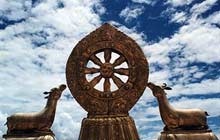
 The Jokhang, or "House of the Lord," is the holiest site in Tibet and is the ultimate pilgrimage destination for Tibetan Buddhists. King Songtsen Gampo first built a temple here in the mid-7th century, but the structure that we see today is largely the result of reconstruction in the 17th century, commissioned by the Fifth Dalai Lama. The Jokhang houses the Jowo Buddha, a Buddhist sculpture brought as part of the dowry of the Chinese Princess Wencheng upon her arrival in Tibet. It is said that upon her husband, King Songtsen Gampo's death, the princess hid the sculpture in the temple. The miraculous survival of this ancient Buddhist sculpture makes it today one of Tibet's most revered images.
The Jokhang, or "House of the Lord," is the holiest site in Tibet and is the ultimate pilgrimage destination for Tibetan Buddhists. King Songtsen Gampo first built a temple here in the mid-7th century, but the structure that we see today is largely the result of reconstruction in the 17th century, commissioned by the Fifth Dalai Lama. The Jokhang houses the Jowo Buddha, a Buddhist sculpture brought as part of the dowry of the Chinese Princess Wencheng upon her arrival in Tibet. It is said that upon her husband, King Songtsen Gampo's death, the princess hid the sculpture in the temple. The miraculous survival of this ancient Buddhist sculpture makes it today one of Tibet's most revered images.
The Jokhang is built on what was formerly a lake. Several legends provide explanations for the selection of this unusual location. The most popular tells of how King Songtsen Gampo tossed a ring from his finger, swearing to build the temple wherever it fell. When the ring landed in the lake, a white stupa appeared magically and the Jokhang was constructed on this site. Another legend explains that Princess Bhrikuti of Nepal, on joining King Songtsen Gampo's court, perceived a great demoness in the Tibetan landscape. Having established that the demoness' heart lay beneath a small lake in Lhasa, she ordered the lake filled and the erection of the Jokhang Temple there.
Above the main entrance to the Jokhang is a golden, eight-spoked Dharma Wheel, flanked by two deer. The spokes of the wheel represent the Eight-fold Path (to enlightenment) and the deer serve as a reminder that Buddha gave his first sermon in a deer park. On any given day, one will be awed by the dozens of pilgrims bodily prostrating themselves before this entrance.
The walls of the first courtyard are lined with hundreds of votive lamps. This is the flickering doorway leading into one of Tibet's most intensely religious atmospheres. The first floor houses a series of chapels, each dedicated to a different deity, monk or king. Behind the numerous sculptures, the chapel walls are covered in vivid murals depicting relevant sutra and historical narratives. A circuitous path between the labyrinthine chapels eventually leads you to the inner sanctum, used daily for worship. At its centre, behind rows of cushions, stand larger than life size statues of Buddhas and Bodhisattvas.
Outside, above the temple's third story rooftops, are an agglomeration of pavilions, comprised of craftsmen's workshops and monks' living quarters. Here, you will glimpse monks debating in one of the numerous back courtyards or perceive their studying forms through the thin curtains of their quarters. Otherwise, looking out, you will enjoy spectacular views across the Barkhor, the pilgrimage route encircling the Jokhang Temple, and across the roofs of Lhasa towards the Potala Palace.